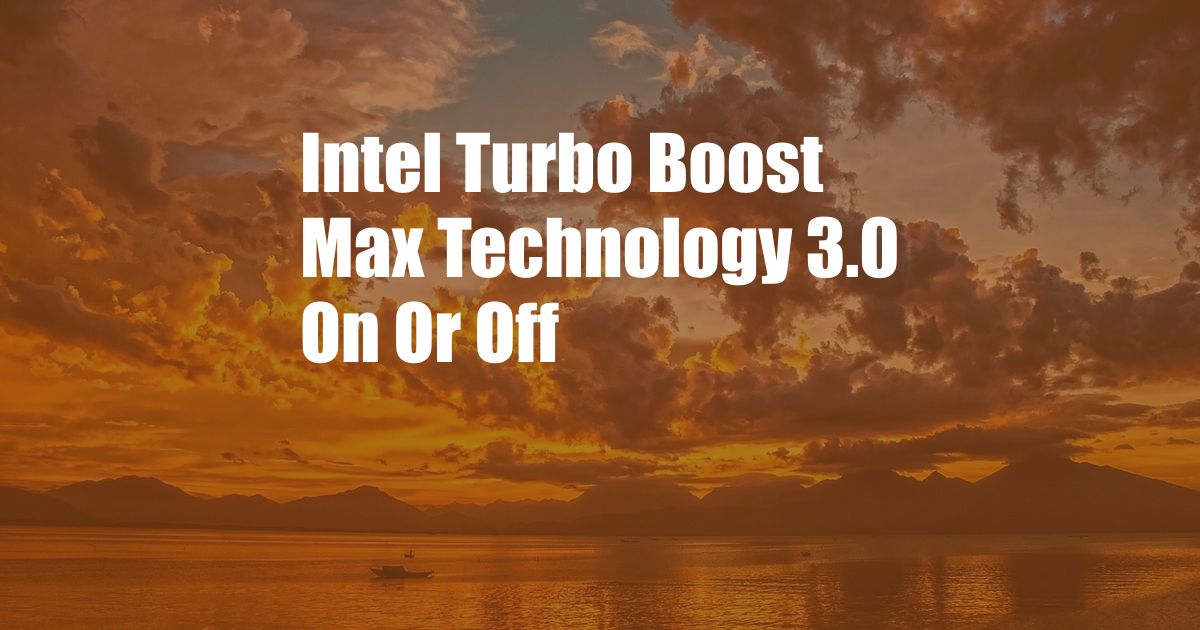
Intel Turbo Boost Max Technology 3.0: Should You Keep It On or Off?
In the realm of computing, Intel’s Turbo Boost Max Technology 3.0 has emerged as a game-changer, promising unparalleled performance for the most demanding tasks. However, a question often arises: is it wise to leave Turbo Boost Max enabled at all times, or should it be selectively toggled on or off?
To fully grasp the significance of this decision, let’s delve into the essence of Turbo Boost Max Technology and explore its pros and cons.
Turbo Boost Max Technology: Unleashing Maximum Performance
Turbo Boost Max Technology is an innovative feature in specific Intel processors that identifies and selects the best-performing core within the chip. When active, it empowers that core to operate at even higher frequencies than the standard Turbo Boost technology allows, resulting in a significant performance boost.
This technology is particularly beneficial for workloads that rely heavily on single-thread performance, such as gaming, rendering, or design software. By dynamically allocating the highest possible frequency to the core most suited for the task, Turbo Boost Max Technology provides an edge in demanding applications.
When to Keep Turbo Boost Max On
- For tasks that demand maximum single-thread performance, such as gaming or content creation.
- When working with intensive applications that require the highest possible clock speeds.
- If overall system responsiveness and smoothness are a priority.
When to Turn Turbo Boost Max Off
- When battery life is a concern, as Turbo Boost Max can increase power consumption.
- For extended periods of light or moderate workloads that do not require the additional performance.
- If the system is prone to overheating, as Turbo Boost Max can generate higher temperatures.
Tips and Expert Advice for Optimal Performance
Enable Turbo Boost Max Selectively: Rather than leaving Turbo Boost Max permanently enabled, consider activating it only when running performance-intensive tasks. This approach balances performance and power efficiency.
Monitor System Temperature: Keep an eye on the system’s temperature while Turbo Boost Max is active. Excessive heat can lead to performance throttling or system instability. Ensure adequate cooling to prevent overheating.
FAQs on Intel Turbo Boost Max Technology 3.0
-
Q: What is the primary benefit of Turbo Boost Max Technology?
A: Providing a significant performance boost for single-thread workloads, particularly in gaming, rendering, and design applications. -
Q: Does Turbo Boost Max increase power consumption?
A: Yes, enabling Turbo Boost Max can lead to higher power consumption. -
Q: Is it always advisable to keep Turbo Boost Max enabled?
A: No, selectively enabling Turbo Boost Max is recommended to balance performance and power efficiency. -
Q: Can Turbo Boost Max cause system instability?
A: Overheating due to excessive Turbo Boost Max usage can potentially lead to system instability. -
Q: Is Turbo Boost Max only available on specific Intel processors?
A: Yes, Turbo Boost Max Technology is exclusive to specific Intel Core processor models.
Conclusion
Intel Turbo Boost Max Technology 3.0 offers a tantalizing proposition: unparalleled single-core performance for demanding tasks. However, the decision to keep it on or off depends on individual needs and usage patterns. By understanding the technology’s benefits and limitations, users can optimize performance, extend battery life, and ensure system stability.
If you are an avid gamer or content creator who prioritizes maximum performance, Turbo Boost Max is your ally. But if power efficiency and thermal management are your concerns, selective usage is the key.
So, dear reader, are you ready to harness the power of Turbo Boost Max and unleash the full potential of your Intel processor? Let the performance journey begin!